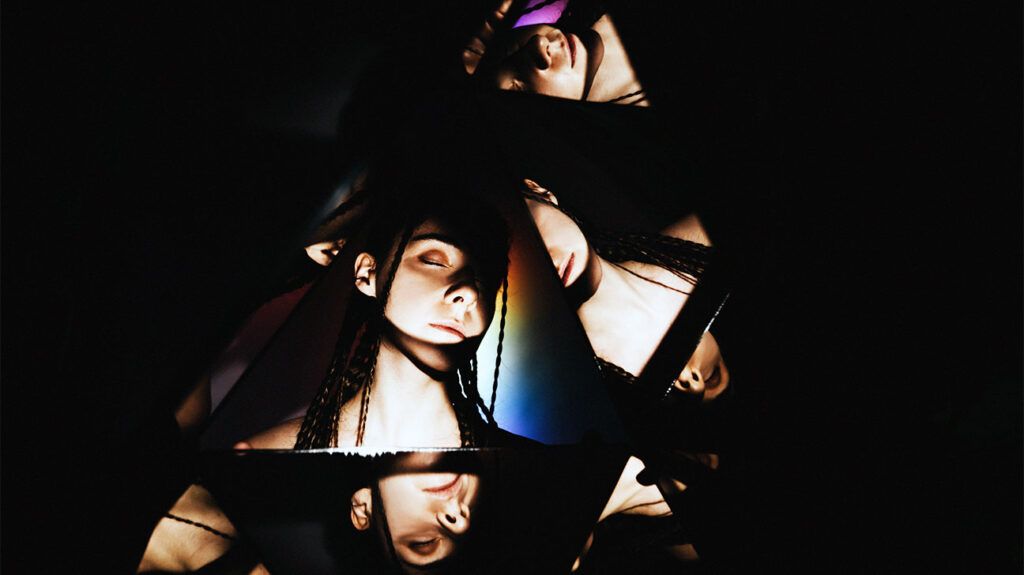Kaleidoscope vision is a symptom of migraine. The brain creates a visual illusion of fractured or bright colors, similar to those a person might see through a kaleidoscope.
Migraine can affect vision in many ways. Some people see sparkling lights or blind spots, while others experience kaleidoscope vision. This visual symptom can occur in one or both eyes but might affect only a small portion of the visual field.
People may also experience kaleidoscope vision due to brain damage or a stroke. However, if it occurs with a stroke, it will typically also involve partial loss of vision.
This article discusses the causes of kaleidoscope vision, how to treat it, and when to consult a doctor.

Below are some potential causes of kaleidoscope vision.
Ocular migraine
Migraine and severe headaches affect approximately
Ocular migraine is not an official, distinct condition in the International Classification of Headache Disorders. However, eye doctors may use the term to refer to migraine episodes with visual symptoms, such as auras.
Ocular migraine may occur with or without a headache. However, people may also experience eye pain and sensitivity to light.
Researchers suggest ocular migraine may be due to atypical activity in the cerebral cortex, which are nerve endings in the back of the brain.
Retinal migraine
Retinal migraine is a rare type of migraine that affects only one eye. Auras can last 5 to 60 minutes, after which people may have a headache. Episodes may occur
Retinal migraine is a type of ocular migraine and may occur due to reduced blood flow to the eye.
Visual aura symptoms due to retinal migraine may include:
- a blind spot that may increase in size
- flashing lights
- temporary loss of sight in one eye
Transient ischemic attack or stroke
Stroke occurs when something interrupts or blocks the blood supply to the brain. Potential causes of stroke
- blood clots
- plaque or fatty deposits
- damaged or ruptured blood vessels
A transient ischemic attack (TIA), or “mini-stroke,” results from a temporary blockage. This type of stroke usually lasts only
A TIA can indicate a high likelihood of having a stroke in the future, so it is important that people inform their doctors if they experience any of the following TIA symptoms:
- numbness or tingling on one side of the body
- confusion
- difficulty speaking
- loss of balance
- dizziness
If a person suspects a stroke, they need to call the emergency services or visit the hospital right away.
Kaleidoscope vision and other visual migraine symptoms will typically go away on their own within 1 hour.
Medications, such as nonsteroidal anti-inflammatory drugs (NSAIDs), may relieve painful symptoms. For example, aspirin
Taking medication during the aura phase of a migraine may also help stop symptoms from progressing.
People who experience aura may also find relief from sitting or lying in a dark, quiet room. Massaging the scalp and applying a damp cloth to the forehead may also help relieve migraine pain.
Some medications, such as beta-blockers, calcium channel blockers, and erenumab (Aimovig) — which targets calcitonin receptors, may effectively prevent migraine episodes.
People can discuss treatment options with their doctor. Other medications that may help manage and prevent migraine symptoms include:
- over-the-counter pain relievers, such as ibuprofen
- triptans
- antiemetics
Experiencing kaleidoscope vision can be concerning, but this symptom will typically pass with time. People can try relaxing and waiting for their vision to return before moving around, driving, or operating machinery.
Kaleidoscope vision is just one of several types of auras that occur in response to a sudden increase in neuronal activity. They can also
There are three types of visual aura:
- Positive aura: This occurs when a person sees something that is not actually there. This will usually be dark zig-zag lines, dots, or flashing bulbs.
- Negative aura: This occurs when a person experiences partial or total vision loss. They may have blind spots, tunnel vision, or total loss of vision in one or both eyes.
- Altered aura: This neither adds nor subtracts from a person’s vision. Instead, it changes the way a person views the world around them. People with altered auras might see objects that move in waves or appear unusually large or small.
Kaleidoscope vision is a type of altered visual aura.
The
- stiff neck
- fever
- nausea or vomiting
- confusion
- vision impairment, such as blurred or double vision
- loss of sensation or weakness in any part of the body
- convulsions
- shortness of breath
People may also want to consider speaking with their doctor if their headache symptoms worsen over several days.
Children or adults over the age of 50 need to seek immediate medical attention if they experience persistent, recurring headaches.
Although many people experience migraine and visual aura symptoms together, migraine can cause kaleidoscope vision before a headache develops.
In some cases, people may also experience kaleidoscope vision due to a stroke.
Stress is a potential trigger for migraine, which may occur with visual auras, such as kaleidoscope vision.
Migraine affects around 12% of people globally, and around 25% of those with migraine experience visual aura symptoms, such as kaleidoscope vision.
Kaleidoscope vision makes the objects in a person’s field of vision appear fractured or broken. Ocular migraine often causes kaleidoscope vision, but the symptom can also indicate a stroke.
People with migraine may experience visual, auditory, or physical symptoms before the head pain starts. No cure exists for migraine or auras. However, individuals can take preventive measures, such as over-the-counter medications or scalp massage, if they feel a migraine starting.
People can also speak with a doctor for individualized support. Individuals need to seek emergency medical attention for a suspected stroke or mini-stroke.


